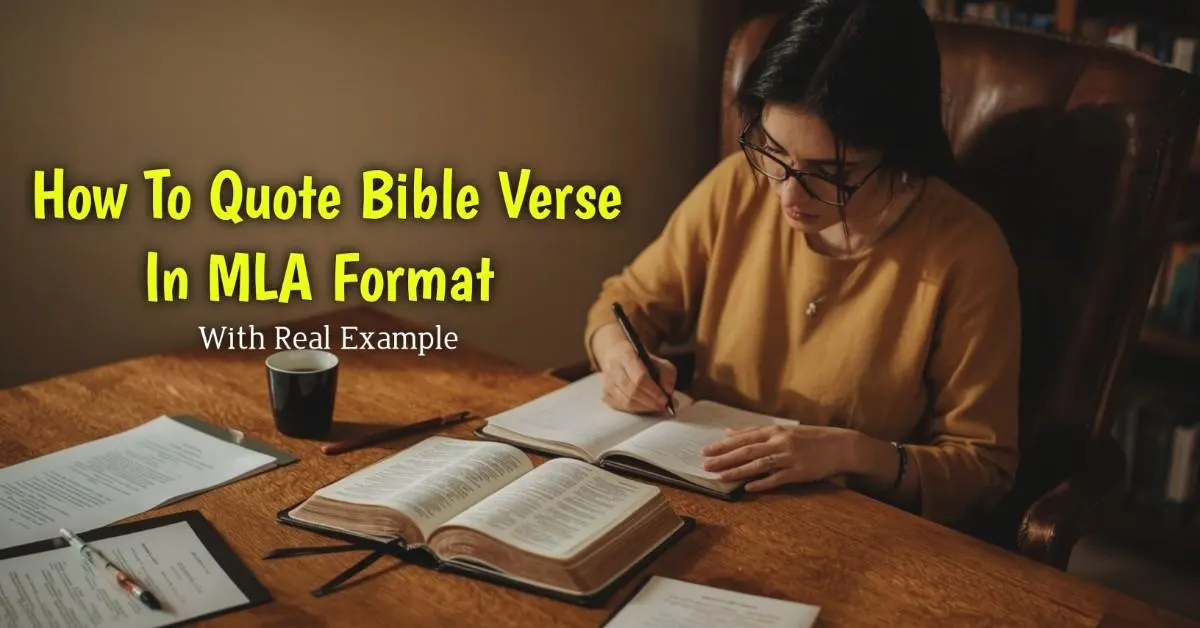Introduction – Why MLA Bible Citation Matters
If you’re wondering how to quote Bible verses MLA style for your school paper, Bible study, or Christian blog, you’re not alone. Many students, faith-based writers, and pastors often face confusion when it comes to citing Scripture correctly using MLA guidelines especially with the latest MLA 9th edition updates.
Quoting the Bible may seem simple at first, but even one formatting error can lead to academic markdowns or confusion for your readers. On the spiritual side, it’s also about respecting the Word of God and sharing it with clarity and reverence. Whether you’re referencing Psalms for a devotional or quoting John’s Gospel in an essay, accuracy matters both for scholarship and faith.
In this guide, we’ll walk you through exactly how to format Bible verses in MLA, provide real examples, and explain when and how to include Bible version names. The goal? To help you write confidently, cite clearly, and honor God’s Word with excellence.
Basic MLA Format Rules for Bible Verses
When you’re quoting Bible verses in MLA style, there are a few simple rules to follow. These help keep your writing clean, respectful, and academically correct.
1. No Page Numbers — Use Chapter and Verse
In MLA, you don’t use page numbers for the Bible. Instead, write the book name, followed by chapter and verse like this: (John 3.16).
2. Italicize the Bible Version
Always italicize the full name of the Bible version you’re using.
Example: New International Version, English Standard Version.
3. Use Parentheses for Citations
Put the Bible reference inside parentheses at the end of the quote.
Example: (Psalm 23.1, New King James Version)
4. Include Version Name Only in First Citation
If you’re using the same Bible version throughout your writing, just mention it the first time. After that, you can skip the version.

MLA In-Text Citation Examples
Let’s look at a few real examples so you can see how it works.
Example 1 (Standard):
“The Lord is my shepherd” (Psalm 23.1, New International Version).
First time quoting — version included and italicized.
Example 2 (Abbreviated):
“God is love” (1 John 4.8, KJV).
After first mention, you can use version abbreviation if it's well-known.
Example 3 (Multiple Translations):
“For God has not given us a spirit of fear” (2 Tim. 1.7, NKJV), while the NIV says, “The Spirit God gave us does not make us timid” (2 Tim. 1.7, NIV).
When using more than one translation, always name each version clearly.
How to Cite the Bible in the Works Cited Page
After quoting the Bible in your writing, MLA style also requires you to add a full citation in the Works Cited section. Here’s how you can format it correctly.
For Print Bibles:
Follow this format:
Title of Bible. Version, Publisher, Year.
Example:
The Holy Bible. King James Version, Thomas Nelson, 2004.
Make sure the version and publisher match the one you used in the text.
For Online Bibles:
Use this format when citing a Bible from a website:
Title of Bible. Version, Publisher, Year, URL.
Example:
The Holy Bible. New International Version, Biblica, 2011, www.biblegateway.com.
Include the full web address and don’t forget to italicize the Bible title.
Common Mistakes to Avoid
Citing the Bible in MLA might seem simple, but many people still make small mistakes that can affect the quality of their writing. Here are some common errors you should avoid:
Don’t use page numbers
MLA format does not require page numbers for the Bible. Always use the book name, chapter, and verse instead — like (John 3.16), not page 25.
Don’t forget to italicize the version
When you mention the Bible version — like NIV, KJV, or ESV — always italicize it. This small detail shows that you’re following proper MLA style.
Don’t use outdated formats (MLA 8 or older)
Make sure you’re following the MLA 9th edition, which is the most current. Using old formats might confuse your readers or cause markdowns in academic work.
Always add a Works Cited entry
An in-text citation is not enough. You must also include a full Works Cited entry at the end of your paper or blog post, whether you’re using a print or online Bible.
Paying attention to these small details helps your writing stay professional, clear, and respectful of God’s Word.
How do you quote a Bible verse in MLA?
To quote a Bible verse in MLA, use the format:
“Verse” (Book Chapter. Verse, Version).
Example: “God is love” (1 John 4.8, NIV).
How do you cite a Bible verse with a quote?
If you’re directly quoting Scripture, place the verse in quotation marks, followed by a parenthetical citation with book, chapter. verse, and Bible version.
Example: “The Lord is my shepherd” (Psalm 23.1, KJV).
How to cite a Bible dictionary in MLA?
MLA format for a Bible dictionary:
Author (if available). “Entry Title.” Title of Dictionary, edited by Editor, Publisher, Year, page.
How to cite religious text in MLA?
For sacred texts like the Bible, use the book name, chapter. verse, and version in parentheses. You should also list the version in your Works Cited.
Example: (Matthew 5.9, ESV)
How to quote Bible verses MLA example?
Here’s a standard MLA example:
“For we live by faith, not by sight” (2 Cor. 5.7, NIV).
How to quote Bible verses MLA online?
For online Bible verses, the in-text format remains the same. In your Works Cited, add the Bible’s title, version, publisher, year, and URL.
Example:
The Holy Bible. New International Version, Biblica, 2011, www.biblegateway.com.
How to quote Bible verses MLA KJV?
Use the King James Version in italics in your citation:
“In the beginning God created the heaven and the earth” (Genesis 1.1, King James Version).
NIV Bible citation MLA?
In-text example: (Romans 8.28, New International Version)
Works Cited:
The Holy Bible. New International Version, Biblica, 2011.
Final Thoughts – Citing the Bible Is Easier Than You Think
At first, MLA Bible citation might feel a bit technical. But once you understand the basic format chapter and verse, italicized version, and a proper Works Cited entry it becomes easy and natural.
Whether you’re writing for school, a blog, or personal study, citing Scripture the right way is more than just a rule. It’s about honoring the Bible and using it responsibly in your writing.
Now that you know how to quote Bible verses MLA, your writing can be both accurate and respectful to God’s Word.

